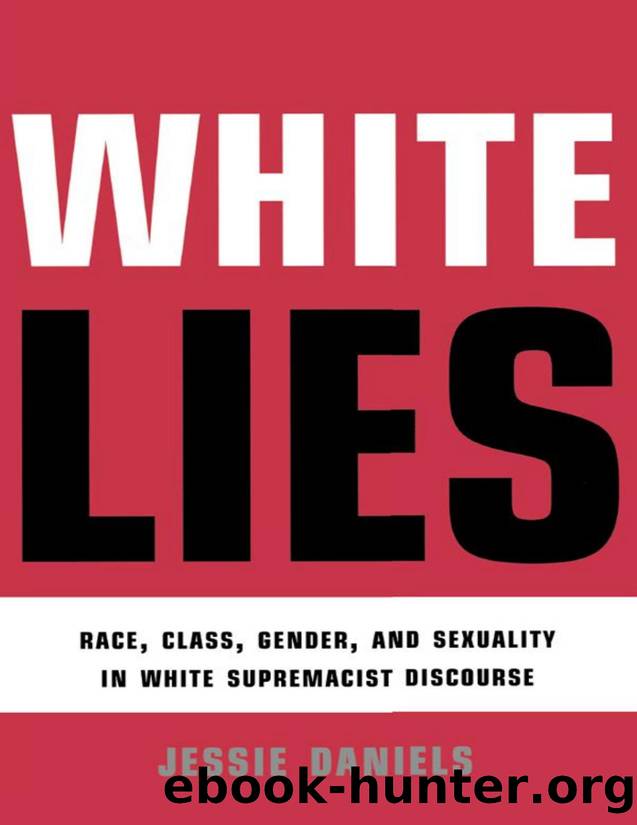White Lies: Race, Class, Gender and Sexuality in White Supremacist Discourse by Jessie Daniels

Author:Jessie Daniels [Daniels, Jessie]
Language: eng
Format: epub
Tags: Gender, Politics, Race, Social Science, Sociology, Non-Fiction
ISBN: 9781134716456
Google: bPpYCwAAQBAJ
Amazon: B01AC99MSE
Publisher: Routledge
Published: 2016-01-08T00:00:00+00:00
opportunities to commit crimes, the organâs capacity for criminal behavior has nearly doubled! ( WAR, vol. 8, nos. 5 and 6, 1989, p. 5)
Then the diagram points to different segments of the brain, one of the smallest of which is labeled âintelligence.â
White supremacist assertions of the allegedly racially based lower intelligence of Blacks are not limited to extremist publications, however, but also appear under the guise of social science research. In the fall of 1994, Charles Murray and Richard Hernstein, fully credentialed academic social science researchers, published The Bell Curve, in which they argued that I.Q. is largely attributable to genetic heritage and that Blacks as a group are less intelligent than whites. The authors also suggest that if low I.Q. scores are related to poverty (as they believe they are), then whites and Blacks alike should accept the reality of Black intellectual disadvantage.
Figure IV.1
The connection between this widely discussed social science research and extremist white supremacist discourse is not a difficult one to make.
First, despite Murrayâs [and while he was alive, Hernsteinâsâhe died just as the book was released] vehement denials of harboring racist sentiment, the discussion presented in The Bell Curve of race and I.Q. bluntly sanctions white supremacist notions about the biological inferiority of Blacks, albeit in much more sophisticated language than the extremist publications. That Hernstein and Murray inundate the reader with an avalanche of charts, graphs, and statistics to substantiate their point makes
it no less an artifact of white supremacist ideology; it merely demonstrates that white supremacy can take on a particularly pernicious form when it appears as social science.
Second, there is a more direct link to white supremacist sources in Murray and Hernsteinâs work. When interviewed by The New York Times, Murray conceded that part of what he found compelling about researching I.Q. and race was that it had the âallure of the forbidden,â and that he and Hernstein were aware of this. âSome of the things we read to do this work, we literally hide when weâre on planes and trains. Weâre furtively peering at this stuff ( New York Times, October 9, 1994, p. 51). Intrigued by what these publications might be, Charles Lane in an article for the New York Review of Books finds that much of the research for The Bell Curve draws on the overtly racist journal The Mankind Quarterly and on the work of avowedly racist âscholarsâ who regularly contribute to Mankind. While Lane contends that Murray and Hernstein should not be held accountable for the views of all the researchers upon whose work they draw, he does argue convincingly that the use of these sources raises serious questions of intellectual honesty. In the interview with the New York Times, Murray conceded that he and a group of friends had, as teenagers in Iowa, burned a cross made of scrap wood on a hillside. The teenagers were surprised when their prank was interpreted as racial harassment of the two Black families in the town. When asked about the incident, Murray remarked, â⦠it never crossed our minds that this had any larger significance.
Download
This site does not store any files on its server. We only index and link to content provided by other sites. Please contact the content providers to delete copyright contents if any and email us, we'll remove relevant links or contents immediately.
Collaborating with Parents for Early School Success : The Achieving-Behaving-Caring Program by Stephanie H. McConaughy; Pam Kay; Julie A. Welkowitz; Kim Hewitt; Martha D. Fitzgerald(854)
Entrepreneurship Education and Training: The Issue of Effectiveness by Colette Henry Frances Hill Claire Leitch(573)
Adding Value to Policy Analysis and Advice by Claudia Scott; Karen Baehler(487)
Race and American Political Development by unknow(472)
Sociological Perspectives of Health and Illness by Constantinos N. Phellas(467)
American Government and Politics Today by Steffen W. Schmidt Mack C. Shelley Barbara A. Bardes(462)
Human and Global Security : An Exploration of Terms by Peter Stoett(451)
Materializing the Middle Passage by Jane Webster;(440)
Control Of Oil - Hardback by Kayal(434)
Advances in Child Development and Behavior, Volume 37 by Patricia J. Bauer(386)
The Catholic Church and European State Formation, AD 1000-1500 by Jørgen Møller(381)
The World According to China by Elizabeth C. Economy(368)
Left Is Not Woke by Susan Neiman(353)
Theories of Counseling and Psychotherapy: A Case Approach by Nancy L. Murdock(350)
The Disappearance of Rituals: A Topology of the Present by Byung-Chul Han(348)
Turkey's Relations with the West and the Turkic Republics: The Rise and Fall of the Turkish Model by Idris Bal(344)
Application of classical statistics, logratio transformation and multifractal approaches to delineate geochemical anomalies in the Zarshuran gold district, NW Iran by unknow(340)
Cross-Cultural Child Development for Social Workers by Lena Robinson(337)
Japan's Ainu Minority in Tokyo by Mark K. Watson(321)
